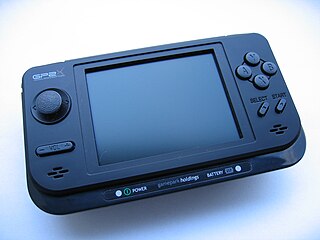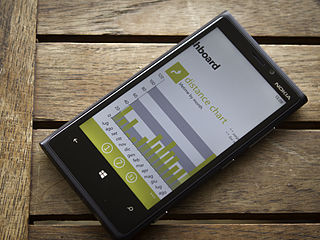Related Research Articles

A vaporizer or vaporiser, colloquially known as a vape, is a device used to vaporize substances for inhalation. Plant substances can be used, commonly cannabis, tobacco, or other herbs or blends of essential oil. However, they are most commonly filled with a combination propylene glycol, glycerin, and drugs such as nicotine or tetrahydrocannabinol as a liquid solution.

The GP2X is a Linux-based handheld video game console and portable media player developed by South Korean company GamePark Holdings. It was released on November 10, 2005, in South Korea only.

A one-hitter is typically a slender pipe with a screened narrow bowl designed for a single inhalation, or "hit", of smoke or vapor from a small serving of heated cannabis flower, tobacco leaf or other dry, sifted herbal preparation. It is distinguished from western-style large-bowl pipes designed for strong tobaccos that are burned hot and tasted but not inhaled. Instead, by properly distancing a lighter flame below the opening, inhalant users operate at vaporization temperatures, minimizing combustion waste and toxicity.

An electronic cigarette (e-cigarette) or vape is a device that simulates tobacco smoking. It consists of an atomizer, a power source such as a battery, and a container such as a cartridge or tank. Instead of smoke, the user inhales vapor. As such, using an e-cigarette is often called "vaping". The atomizer is a heating element that vaporizes a liquid solution called e-liquid, which quickly cools into an aerosol of tiny droplets, vapor and air. The vapor mainly comprises propylene glycol and/or glycerin, usually with nicotine and flavoring. Its exact composition varies, and depends on several things including user behavior.

Hash oil or cannabis oil is an oleoresin obtained by the extraction of cannabis or hashish. It is a cannabis concentrate containing many of its resins and terpenes – in particular, tetrahydrocannabinol (THC), cannabidiol (CBD), and other cannabinoids. Hash oil is usually consumed by smoking, vaporizing or eating. Preparations of hash oil may be solid or semi-liquid colloids depending on both production method and temperature and are usually identified by their appearance or characteristics. Color most commonly ranges from transparent golden or light brown, to tan or black. There are various extraction methods, most involving a solvent, such as butane or ethanol.

The Magic Mouse is a multi-touch wireless mouse sold by Apple Inc. and manufactured by Foxconn. The first-generation Magic Mouse was released on October 20, 2009, and introduced multi-touch functionality to a computer mouse. Taking after the iPhone, iPod Touch, and multi-touch MacBook trackpads, the Magic Mouse allows the use of multi-touch gestures and inertia scrolling across the surface of the mouse, designed for use with macOS.

Nokia Lumia 920 is a smartphone developed by Nokia that runs the Windows Phone 8 operating system. It was announced on September 5, 2012, and was first released on November 2, 2012. It has a 1.5 GHz dual-core Qualcomm Krait CPU and a 4.5" IPS TFT LCD display, as well as a high-sensitivity capacitive touchscreen that can be used with gloves and fingernails; the display is covered by curved Gorilla Glass and has a 9 ms response time. The phone features an 8.7-megapixel PureView camera with OIS; it was the first smartphone camera to implement that technology, as well as to support Qi inductive charging. The phone comes with 32 GB of internal storage, but has no expandable storage.

Honor Device Co., Ltd., commonly known as HONOR, is a Chinese consumer electronics company majority-owned by Shenzhen Zhixin New Information Technology Co. Ltd. It was formerly a subsidiary of Huawei, who sold the brand in November 2020. Honor develops smartphones, tablet computers, wearables and mobile device softwares.

Nexus 5 is an Android smartphone sold by Google and manufactured by LG Electronics. It is the fifth generation of the Nexus series, succeeding the Nexus 4. It was unveiled on October 31, 2013 and served as the launch device for Android 4.4 "KitKat", which introduced a refreshed interface, performance improvements, greater Google Now integration, and other changes. Much of the hardware is similar to the LG G2 which was also made by LG and released earlier that year.

Regulation of electronic cigarettes varies across countries and states, ranging from no regulation to banning them entirely. As of 2015, around two thirds of major nations have regulated e-cigarettes in some way. A 2023 report by the World Health Organization (WHO) found that 34 countries had banned the sale of e-cigarettes.
Pax Labs is an American electronic vaporizer company founded in 2007 that markets the Pax vaporizers. The company developed the Juul e-cigarette. Juul Labs was spun out as a separate company in 2017.
The use of electronic cigarettes (vaping) carries health risks. The risk depends on the fluid and varies according to design and user behavior. In the United Kingdom, vaping is considered by some to be around 95% less harmful than tobacco after a controversial landmark review by Public Health England.

Cloud-chasing is the activity of blowing large clouds of vapor using an electronic cigarette. Using the devices for "cloud-chasing" began in the West Coast of the US. The exact origins of the activity are unclear, but most competitive e-cigarette users say that it started around 2012. Competitive vaping is increasing in popularity internationally, spreading from the US and Canada to Indonesia. Cloud-chasing is a recreational activity and a hobby.

An electronic cigarette is a handheld battery-powered vaporizer that simulates smoking, but without tobacco combustion. E-cigarette components include a mouthpiece, a cartridge, a heating element/atomizer, a microprocessor, a battery, and some of them have an LED light on the end. An atomizer consists of a small heating element, or coil, that vaporizes e-liquid and a wicking material that draws liquid onto the coil. When the user inhales a flow sensor activates the heating element that atomizes the liquid solution; most devices are manually activated by a push-button. The e-liquid reaches a temperature of roughly 100–250 °C (212–482 °F) within a chamber to create an aerosolized vapor. The user inhales an aerosol, which is commonly but inaccurately called vapor, rather than cigarette smoke. Vaping is different from smoking, but there are some similarities, including the hand-to-mouth action of smoking and an aerosol that looks like cigarette smoke. The aerosol provides a flavor and feel similar to tobacco smoking. There is a learning curve to use e-cigarettes properly. E-cigarettes are cigarette-shaped, and there are many other variations. E-cigarettes that resemble pens or USB memory sticks are also sold that may be used unobtrusively.

The chemical composition of the electronic cigarette aerosol varies across and within manufacturers. Limited data exists regarding their chemistry. However, researchers at Johns Hopkins University analyzed the vape clouds of popular brands such as Juul and Vuse, and found "nearly 2,000 chemicals, the vast majority of which are unidentified."

A vape shop is a retail outlet specializing in the selling of vaping products, though shops selling derived psychoactive cannabis products have increased in the United States since the passage of the 2018 Farm Bill. There are also online vape shops. A vape shop offers a range of vaping products. The majority of vape shops do not sell vaping products that are from "Big Tobacco" companies. In 2013, online search engine searches on vape shops surpassed searches on e-cigarettes. Around a third of all sales of vaping products in one US state took place in vape shops. Big Tobacco believes the independent vape market is a threat to their interests.

Juul Labs, Inc. is an American electronic cigarette company that spun off from Pax Labs in 2017. Juul Labs makes the Juul electronic cigarette, which atomizes nicotine salts derived from tobacco supplied by one-time use cartridges.
Vuse is an electronic cigarette produced by R. J. Reynolds Vapor Company, a subsidiary of the Reynolds American tobacco company. In 2015, it was the most popular e-cigarette in the United States with 33% market share in Nielsen-tracked channels. However, Vuse lost its top position in 2017, when Juul overtook it to become the most popular e-cigarette in the US. As of August 2018, Vuse controlled 10% percent of the American e-cigarette market, compared to Juul's 72% market share. By September 2023, however, Vuse's market share stood at 41.5% versus Juul's 24.7% market share.
NJOY, LLC is an American company that manufactures and distributes electronic cigarettes and vaping products. In 2017, NJOY acquired the assets of NJOY, Inc., one of the first companies to sell e-cigarettes. On June 1, 2023, the company was acquired by Altria Group.
References
- ↑ @420proguide, Nathan. "Walnut Launch Box Kit Vape Review". Vela Community. Retrieved 3 December 2021.
{{cite web}}: CS1 maint: numeric names: authors list (link) - ↑ Team, Editorial (13 February 2020). "Walnut Launch Box Kit Vape Review". WayOfLeaf.com. Retrieved 3 December 2021.
- ↑ [the-effective-choice "The Effective Choice order page"]. magic-flight.com. Retrieved 22 June 2023.
{{cite web}}: Check|url=value (help) - ↑ Scwartz, Matthias (4 November 2015). "Letter of Recommendation: Magic-Flight Launch Box". The New York Times. Retrieved 3 December 2021.
- ↑ Tarantola, Andrew (20 July 2012). "Magic-Flight Launchbox Review: You Might As Well Just Whittle It Yourself". Gizmodo . Retrieved 3 December 2021.